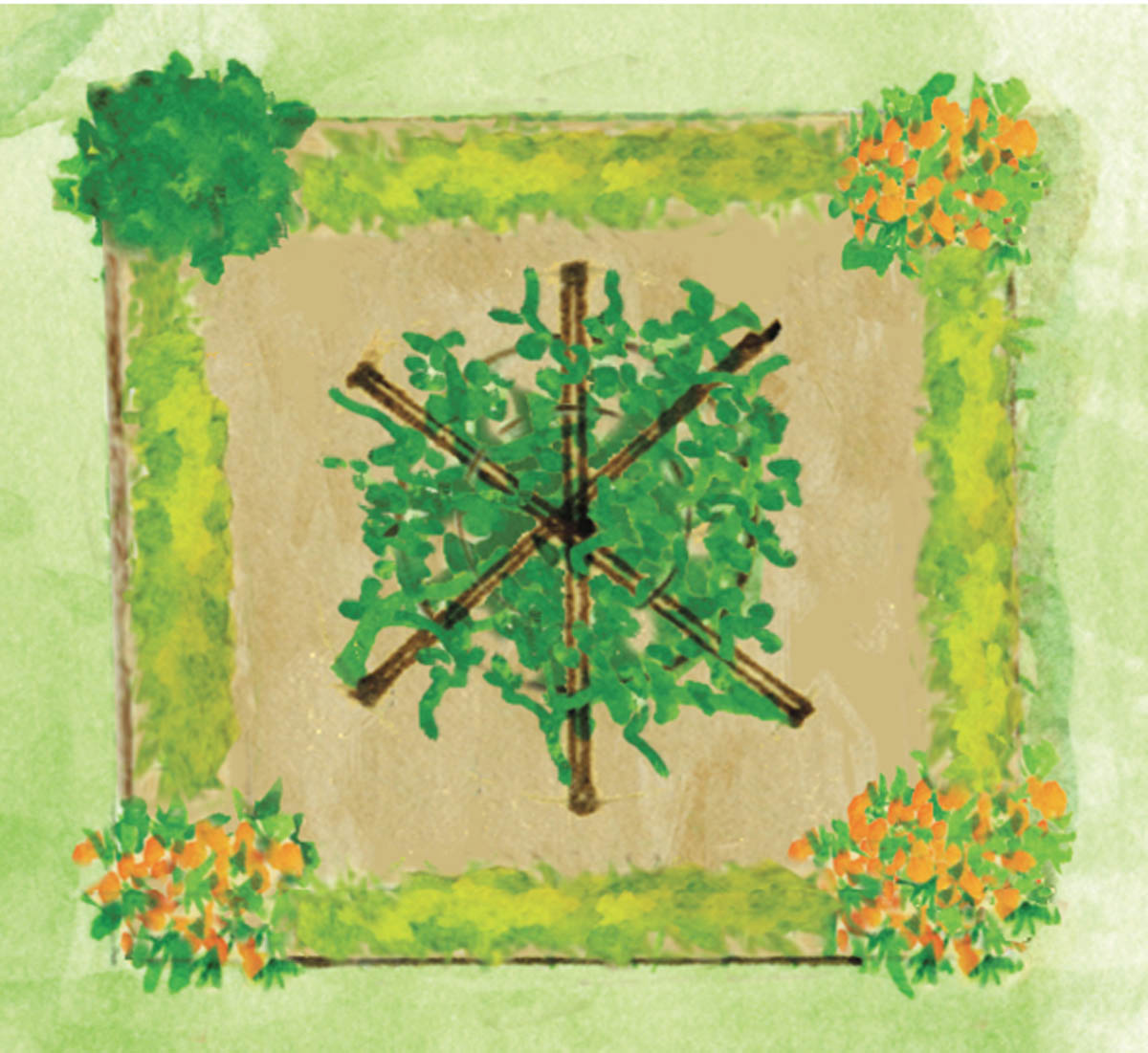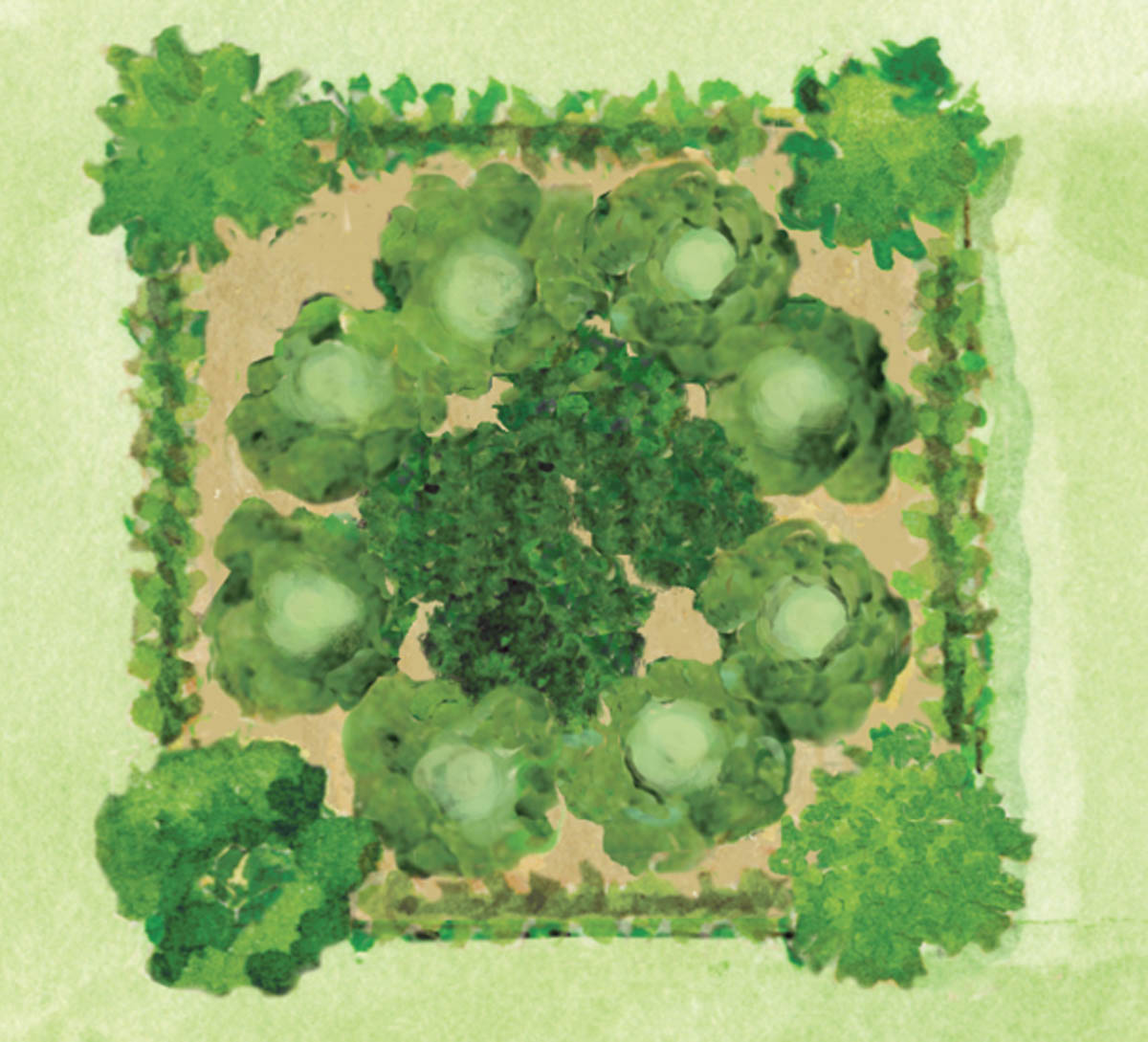
Teresa O’Connor’s “Founding Fathers Garden” design fuses elements and varieties from the gardens at George Washington’s Mount Vernon, Thomas Jefferson’s Monticello, and Colonial Williamsburg. The result is a traditional four-square plot that she has surrounded with espaliered apple and pear trees. Her plant choices reflect some of the crops grown by Thomas Jefferson at Monticello, including several of his favorite varieties. Because some of these heritage edibles may be difficult to source, more widely available or recent varieties can be substituted.
Teresa O’Connor has created a garden that weaves history and food production into an attractive and productive plot ideal for a modern gardener. The garden measures just 20 by 20 feet and is surrounded by a rustic wooden fence that supports a variety of espaliered apple and pear trees. Espaliered fruit trees were admired by colonial gardeners, including George Washington, for their ornamental appearance as well as their fruit. Inside the enclosure she has placed four raised beds and, at the very center, a cistern. Teresa says that a different water feature such as a solar-powered fountain could be used instead of the cistern. “In earlier times, cisterns collected rainwater for irrigating the gardens. This is still a very good idea, considering the frequent droughts across much of the United States,” she adds.
Historical spring plantings. The 4- by 4-foot raised beds are the primary production areas of the garden, with each square featuring an assortment of vegetables and herbs that were enjoyed at Mount Vernon, Monticello, or Colonial Williamsburg. Teresa’s plant choices come from several sources, including the books A Rich Spot of Earth by Peter Hatch and Vegetable Gardening: The Colonial Williamsburg Way by Wesley Greene, and reflect the spring planting season.
Asparagus, a long-lived perennial vegetable, was a particular favorite of Thomas Jefferson. At Monticello, where the asparagus bed was carefully amended with well-rotted manure, Jefferson grew old varieties including ‘Cooper’s Pale Green’ and ‘East India’.

The asparagus is surrounded by an early seeding of lettuce, with a thyme plant tucked into the inside corner facing the cistern. “Lettuce was eaten fresh in salads, steamed like spinach, or cooked for soups,” says Teresa. Once spring turns to summer, she recommends replacing the first crop of lettuce with heat-tolerant varieties. “Jefferson grew lettuces even in hot Virginia summers,” she says, recommending old or new varieties that can stand up to hot weather, such as ‘Black Seeded Simpson’ and ‘Red Sails’.
Teresa has devoted this bed to artichokes and brightly colored nasturtiums, with another thyme plant nestled into the inside corner near the cistern. “Artichokes were a popular gentleman farmer’s trophy vegetable, and the mild Virginia climate allowed the perennials to survive with winter support,” says Teresa.

Eighteenth-century gardeners had multiple uses for nasturtiums. “Nasturtium seeds were often pickled and used as a substitute for capers in the early Virginia kitchen. A popular 1824 recipe was to cover nasturtium buds with salted boiling water, let them stand a few days, then strain and cover with vinegar and spices,” she explains. Gardeners also enjoyed the edible leaves and flowers.
Peas were Thomas Jefferson’s favorite crop. “He devoted a great deal of garden space to this cool-season vegetable,” Teresa relates. To support the peas, as well as other climbing and vining vegetables, Thomas Jefferson often used teepees constructed from peach tree clippings. Teresa has added such a teepee, although modern gardeners may need to use bamboo or saplings if branches pruned from peach trees aren’t readily available.

Surrounding the pea teepee is a border of carrots with clumps of calendula at each corner. Calendula has been a culinary and medicinal herb for centuries. “The petals of calendula were used to dye cheeses and were thrown into stews,” Teresa says. “Before 1800, this annual was usually known as ‘marygold’ by gardeners, and Jefferson planted the cheerful flowers both at his Shadwell boyhood home and also at Monticello.” Once the warm weather of summer arrives, she recommends replacing the peas with beans.
This bed is edged with radishes, with a different herb (thyme, marjoram, parsley, and tarragon) at each corner. Teresa notes that all of these were commonly eaten in Jefferson’s time, although he reported trouble growing tarragon at Monticello. The middle of the bed is planted with hardy and productive kale and cabbage.

“Cabbage was very popular, providing nutrition especially in the colder months,” she says. “Jefferson grew more than 30 types of cabbage, including ‘Choux de Milan’ and ‘Green-Curled Savoy’, a variety no longer available.” Once the early crops are finished, she suggests replacing the kale and cabbage with tomatoes, peppers, and eggplants — though these vegetables were just starting to win acceptance into the kitchen garden during Jefferson’s lifetime, as many gardeners had thought them to be poisonous because of their membership in the often-lethal nightshade family.
Lettuce was often used in cooking. Teresa notes that it was eaten fresh, steamed, or cooked in soup.
Thomas Jefferson wrote, “A thimbleful of lettuce should be sowed every Monday morning, from Feb 1st to Sept 1st.”


1. Apples: ‘Newtown Pippin’, ‘Esopus Spitzenberg’, and ‘Lady’ (espaliered)
2. Pears: ‘Lawson’, ‘Bloodgood’, and ‘Howell’ (espaliered)
16. Pot of lavender
17. Rosemary topiary
3. Asparagus: ‘Cooper’s Pale Green’ and ‘East India’
4. Lettuce: ‘Brown Dutch’, ‘Tennis Ball’, and ‘Marseilles’
5. Thyme
5. Thyme
6. Artichokes: ‘Green Globe’
7. Nasturtiums: climbing or ‘Empress of India’
5. Thyme
8. Peas: ‘Prince Albert’ and ‘Blue Prussian’ (on teepee)
9. Calendulas
10. Carrots: ‘Danvers Half Long’ and ‘St. Valery’
11. Kale and cabbage: ‘Delaware’ and ‘Malta’ kale; ‘Choux de Milan’ and ‘Green Curled Savoy’ cabbage
12. Radishes: ‘Early Scarlet Globe’
13. Marjoram
14. Tarragon
15. Parsley